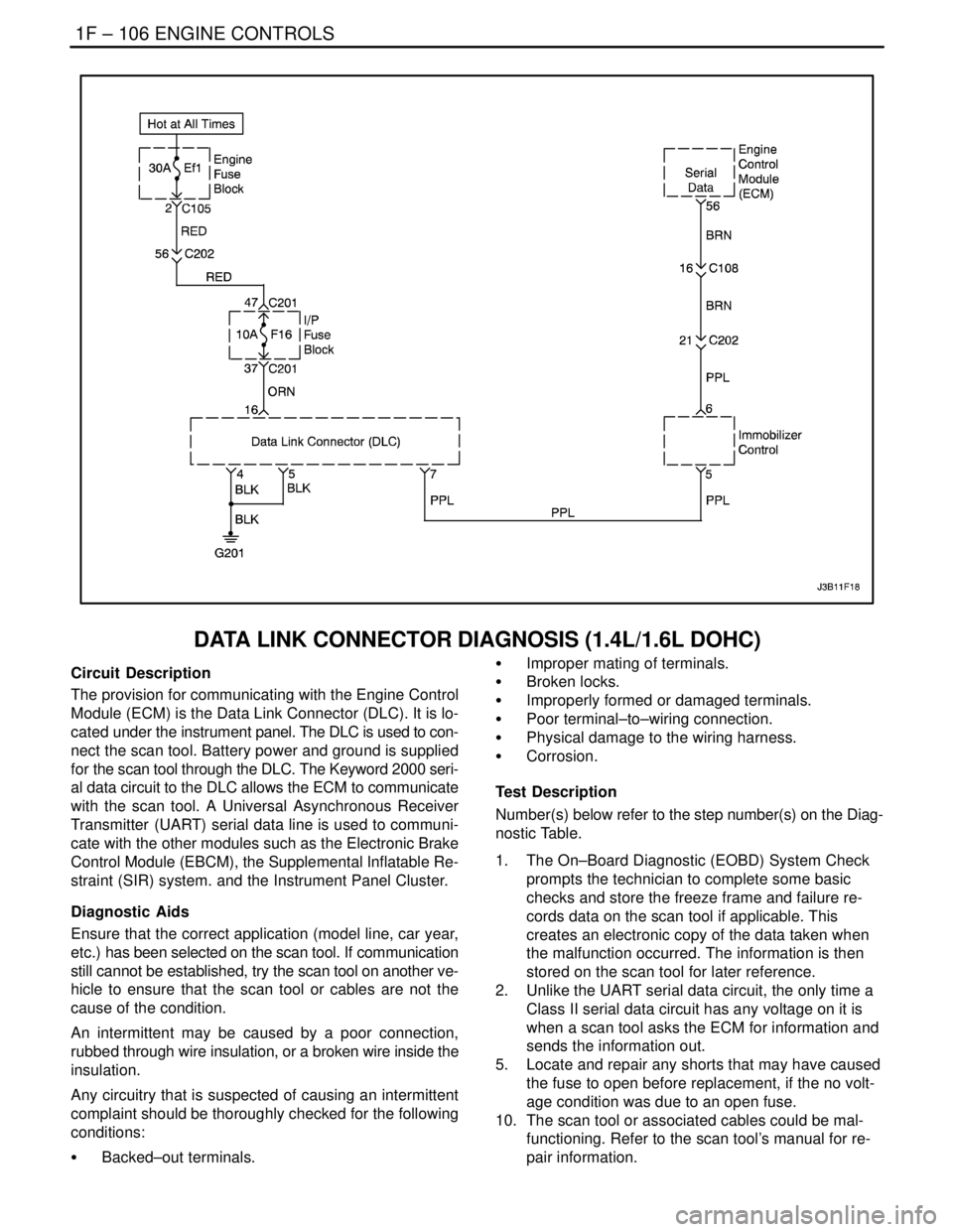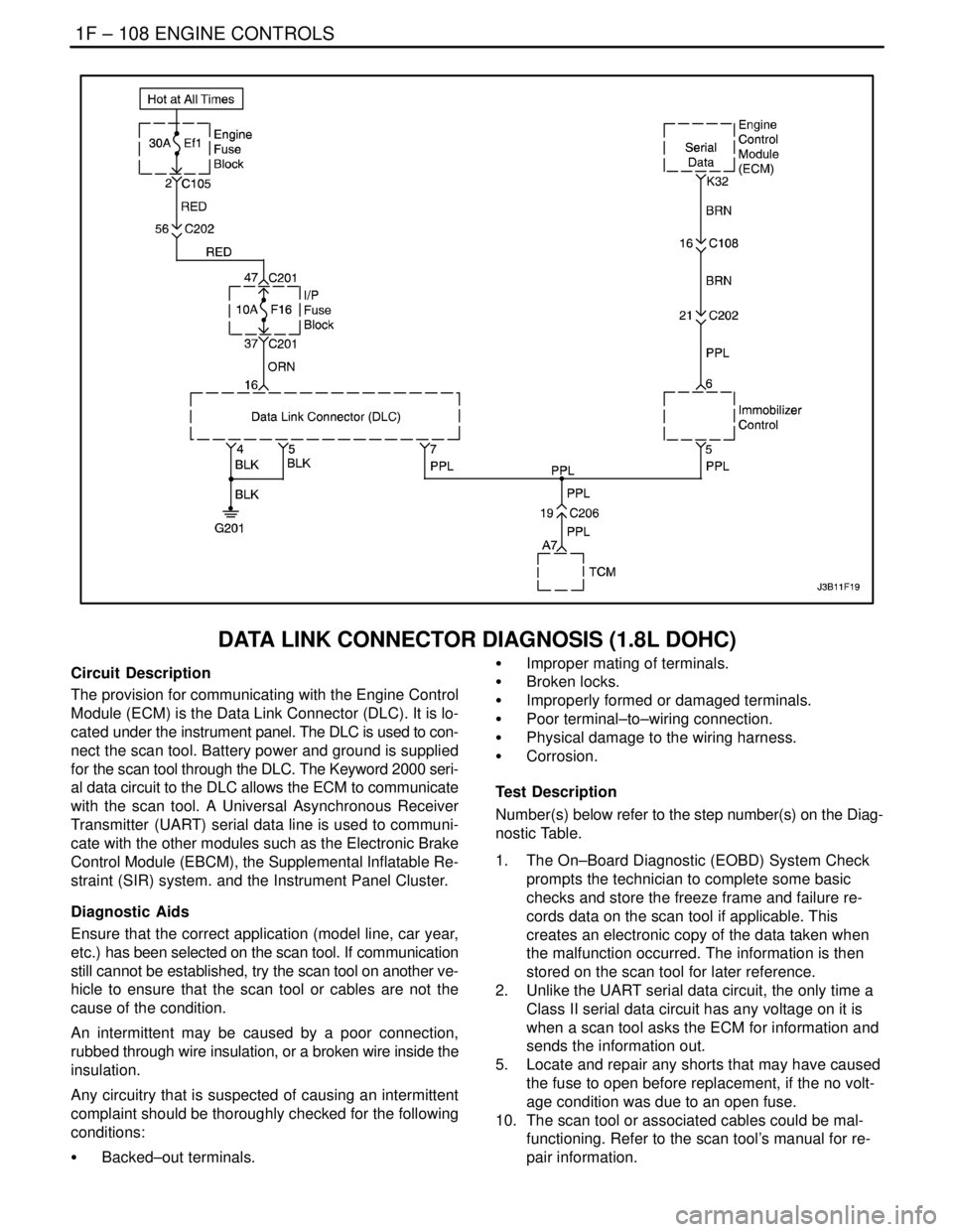2004 DAEWOO LACETTI engine controls
[x] Cancel search: engine controlsPage 349 of 2643

ENGINE CONTROLS 1F – 103
DAEWOO V–121 BL4
StepNo Yes Value(s) Action
20Check the wire between the cooling fan control relay
connector terminal 87A and the auxiliary cooling fan
connector terminal 2 for an open.
Is the problem found?–Go to Step 22Go to Step 21
21Check for an open wire between the auxiliary cooling
fan connector terminal 1 and ground.
Is the problem found?–Go to Step 22Go to Step 29
22Repair the open wire as needed.
Is the repair complete?–System OK–
23Repair the open between the cooling fan relay Low
connector terminal 30 and the fuse Ef21.
Is the repair complete?–System OK–
24Repair the open between the cooling fan relay Low
connector terminal 86 and the ignition switch.
Is the repair complete?–System OK–
25Repair the open wire between the cooling fan relay
Low connector terminal 85 and the ECM connector
terminal K28.
Is the repair complete?–System OK–
26Replace the cooling fan relay Low.
Is the repair complete?–System OK–
27Replace the cooling fan control relay.
Is the repair complete?–System OK–
28Replace the main cooling fan.
Is the repair complete?–System OK–
29Replace the auxiliary cooling fan.
Is the repair complete?–System OK–
30Replace the ECM.
Is the repair complete?–System OK–
311. Turn the ignition OFF.
2. Disconnect the main cooling fan connector.
3. Connect a test light between the main cooling
fan connector termina 2 and ground.
4. Turn the A/C switch ON.
5. Start the engine.
Is the test light on?–Go to Step 32Go to Step 12
321. Turn the ignition OFF.
2. Connect a test light between the main cooling
fan connector terminal 1 and battery positive.
3. Turn the A/C switch ON.
4. Start the engine.
Is the test light on?–Go to Step 28Go to Step 17
331. Turn the ignition OFF.
2. Disconnect the cooling fan relay Hi.
3. Connect a test light between the cooling fan
relay Hi connector terminal 86 and ground.
4. Turn the ignition ON.
Is the test light on?–Go to Step 34Go to Step 44
Page 350 of 2643

1F – 104IENGINE CONTROLS
DAEWOO V–121 BL4
StepNo Yes Value(s) Action
341. Turn the ignition OFF.
2. Connect a test light between the cooling fan
relay Hi connector terminal 30 and ground.
Is the test light on?–Go to Step 35Go to Step 45
351. Disconnect the cooling fan control relay.
2. Connect a test light between the cooling fan
control relay connector terminal 85 and ground.
3. Turn the ignition ON.
Is the test light on?–Go to Step 36Go to Step 46
361. Turn the ignition OFF.
2. Connect a test light between the cooling fan
control relay connector terminal 87 and battery
positive.
Is the test light on?–Go to Step 37Go to Step 47
371. Connect the main cooling fan connector.
2. Connect the cooling fan relay Hi.
3. Connect the cooling fan control relay.
4. Disconnect the ECM connector.
5. Connect a fused jumper between the ECM
connector terminal K28 and ground.
6. Connect a fused jumper between the ECM
connector terminal K12 and ground.
7. Turn the ignition ON.
Do the cooling fans run at high speed?–Go to Step 30Go to Step 38
381. Turn the ignition OFF.
2. Check for an open wire between the cooling
fan relay Hi connector terminal 85 and the
ECM connector terminal K12.
Is the problem found?–Go to Step 22Go to Step 39
391. Disconnect the cooling fan relay Hi.
2. Connect a test light between the cooling fan
relay Hi connector terminal 87 and battery posi-
tive.
Is the test light on?–Go to Step 40Go to Step 48
401. Disconnect the ECM connector.
2. Connect a fused jumper between the ECM
connector terminal K12 and ground.
3. Disconnect the cooling fan relay Hi.
4. Connect a test light between the cooling fan
control relay connector terminal 86 and battery
positive.
Is the test light on?–Go to Step 41Go to Step 49
Page 351 of 2643

ENGINE CONTROLS 1F – 105
DAEWOO V–121 BL4
StepNo Yes Value(s) Action
411. Connect the cooling fan control relay.
2. Connect a fused jumper between the ECM
connector terminal K12 and ground.
3. Disconnect the cooling fan relay Hi.
4. Connect a fused jumper between the cooling
fan relay Hi connector terminals 30 and 87.
5. Disconnect the low speed cooling fan relay.
6. Connect a fused jumper between the low
speed cooling fan relay connector terminals 30
and 87.
7. Turn the ignition ON.
Do the cooling fans run at high speed?–Go to Step 43Go to Step 42
421. Turn the ignition OFF.
2. Connect a fused jumper between the ECM
connector terminal K12 and ground.
3. Disconnect the cooling fan control relay.
4. Connect a fused jumper between the cooling
fan control relay connector terminals 30 and
87.
5. Connect a fused jumper between the low
speed cooling fan relay connector terminals 30
and 87.
6. Turn the ignition ON.
Do the cooling fans run at high speed?–Go to Step 27–
43Replace the cooling fan relay Hi.
Is the repair complete?–System OK–
44Repair the open wire between the cooling fan relay
Hi connector terminal 86 and the ignition switch.
Is the repair complete?–System OK–
45Repair the open wire between the cooling fan relay
Hi connector terminal 30 and the battery.
Is the repair complete?–System OK–
46Repair the open wire between the cooling fan control
relay connector terminal 85 and the ignition switch
Is the repair complete?–System OK–
47Repair the open wire between the cooling fan control
relay connector terminal 87 and ground.
Is the repair complete?–System OK–
48Repair the open wire between the cooling fan relay
Hi connector terminal 87 and the auxiliary cooling
fan connector terminal 2.
Is the repair complete?–System OK–
49Repair the open wire between the cooling fan control
relay connector terminal 85 and the ECM connector
terminal K12.
Is the repair complete?–System OK–
Page 352 of 2643

1F – 106IENGINE CONTROLS
DAEWOO V–121 BL4
DATA LINK CONNECTOR DIAGNOSIS (1.4L/1.6L DOHC)
Circuit Description
The provision for communicating with the Engine Control
Module (ECM) is the Data Link Connector (DLC). It is lo-
cated under the instrument panel. The DLC is used to con-
nect the scan tool. Battery power and ground is supplied
for the scan tool through the DLC. The Keyword 2000 seri-
al data circuit to the DLC allows the ECM to communicate
with the scan tool. A Universal Asynchronous Receiver
Transmitter (UART) serial data line is used to communi-
cate with the other modules such as the Electronic Brake
Control Module (EBCM), the Supplemental Inflatable Re-
straint (SIR) system. and the Instrument Panel Cluster.
Diagnostic Aids
Ensure that the correct application (model line, car year,
etc.) has been selected on the scan tool. If communication
still cannot be established, try the scan tool on another ve-
hicle to ensure that the scan tool or cables are not the
cause of the condition.
An intermittent may be caused by a poor connection,
rubbed through wire insulation, or a broken wire inside the
insulation.
Any circuitry that is suspected of causing an intermittent
complaint should be thoroughly checked for the following
conditions:
S Backed–out terminals.S Improper mating of terminals.
S Broken locks.
S Improperly formed or damaged terminals.
S Poor terminal–to–wiring connection.
S Physical damage to the wiring harness.
S Corrosion.
Test Description
Number(s) below refer to the step number(s) on the Diag-
nostic Table.
1. The On–Board Diagnostic (EOBD) System Check
prompts the technician to complete some basic
checks and store the freeze frame and failure re-
cords data on the scan tool if applicable. This
creates an electronic copy of the data taken when
the malfunction occurred. The information is then
stored on the scan tool for later reference.
2. Unlike the UART serial data circuit, the only time a
Class II serial data circuit has any voltage on it is
when a scan tool asks the ECM for information and
sends the information out.
5. Locate and repair any shorts that may have caused
the fuse to open before replacement, if the no volt-
age condition was due to an open fuse.
10. The scan tool or associated cables could be mal-
functioning. Refer to the scan tool’s manual for re-
pair information.
Page 353 of 2643

ENGINE CONTROLS 1F – 107
DAEWOO V–121 BL4
Data Link Connector Diagnosis (1.4L/1.6L DOHC)
StepActionValue(s)YesNo
1Perform an On–Board Diagnostic (EOBD) system
check.
Was the check performed?–Go to Step 2Go to
”On–Board
Diagnostic Sys-
tem Check”
2With a test light connected to the ground, probe the
Data Link Connector (DLC) battery feed terminal 16.
Is the test light illuminate?–Go to Step 4Go to Step 3
3Repair an open or short to ground in the DLC battery
feed circuit .
Is the repair complete?–Go to Step 4–
4With a test light connected to the battery, probe the
DLC ground terminal 4.
Is the test light illuminate?–Go to Step 6Go to Step 5
5Repair an open circuit.
Is the repair complete?–Go to Step 6–
61. Turn the ignition switch to LOCK.
2. Install the scan tool to the DLC.
3. Turn the ignition switch to ON.
Does the scan tool power up?–Go to Step 8Go to Step 7
7Check for damages in the terminal of DLC and scan
tool, and repair as needed.
Is the repair complete?–Go to Step 8–
8Using a scan tool, request engine data of Engine
Control Module (ECM).
Does the scan tool display any data?–Go to Step 12Go to Step 9
9Install the scan tool on another vehicle and check for
proper operation.
Does the scan tool work properly on a different ve-
hicle.–Go to Step 11Go to Step 10
10The scan tool is malfunctioning.
Refer to the scan tool’s manual for repair.
Is the repair complete?–Go to Step 12–
11Repair communication circuit between ECM and
DLC.
Is the repair complete?–Go to Step 12–
121. Using a scan tool, clear the Diagnostic Trouble
Codes(DTCs).
2. Attempt to start the engine.
Does the engine and continue to run?–Go to Step 13Go to Step 2
131. Allow the engine to idle until normal operation
temperature reached.
2. Check if any DTCs are set?
Are any DTCs displayed that have not been diag-
nosed?–Go to
”Applicable
DTC Table”System OK
Page 354 of 2643

1F – 108IENGINE CONTROLS
DAEWOO V–121 BL4
DATA LINK CONNECTOR DIAGNOSIS (1.8L DOHC)
Circuit Description
The provision for communicating with the Engine Control
Module (ECM) is the Data Link Connector (DLC). It is lo-
cated under the instrument panel. The DLC is used to con-
nect the scan tool. Battery power and ground is supplied
for the scan tool through the DLC. The Keyword 2000 seri-
al data circuit to the DLC allows the ECM to communicate
with the scan tool. A Universal Asynchronous Receiver
Transmitter (UART) serial data line is used to communi-
cate with the other modules such as the Electronic Brake
Control Module (EBCM), the Supplemental Inflatable Re-
straint (SIR) system. and the Instrument Panel Cluster.
Diagnostic Aids
Ensure that the correct application (model line, car year,
etc.) has been selected on the scan tool. If communication
still cannot be established, try the scan tool on another ve-
hicle to ensure that the scan tool or cables are not the
cause of the condition.
An intermittent may be caused by a poor connection,
rubbed through wire insulation, or a broken wire inside the
insulation.
Any circuitry that is suspected of causing an intermittent
complaint should be thoroughly checked for the following
conditions:
S Backed–out terminals.S Improper mating of terminals.
S Broken locks.
S Improperly formed or damaged terminals.
S Poor terminal–to–wiring connection.
S Physical damage to the wiring harness.
S Corrosion.
Test Description
Number(s) below refer to the step number(s) on the Diag-
nostic Table.
1. The On–Board Diagnostic (EOBD) System Check
prompts the technician to complete some basic
checks and store the freeze frame and failure re-
cords data on the scan tool if applicable. This
creates an electronic copy of the data taken when
the malfunction occurred. The information is then
stored on the scan tool for later reference.
2. Unlike the UART serial data circuit, the only time a
Class II serial data circuit has any voltage on it is
when a scan tool asks the ECM for information and
sends the information out.
5. Locate and repair any shorts that may have caused
the fuse to open before replacement, if the no volt-
age condition was due to an open fuse.
10. The scan tool or associated cables could be mal-
functioning. Refer to the scan tool’s manual for re-
pair information.
Page 355 of 2643

ENGINE CONTROLS 1F – 109
DAEWOO V–121 BL4
Data Link Connector Diagnosis (1.8L DOHC)
StepActionValue(s)YesNo
1Perform an On–Board Diagnostic (EOBD) system
check.
Was the check performed?–Go to Step 2Go to
”On–Board
Diagnostic Sys-
tem Check”
2With a test light connected to the ground, probe the
Data Link Connector (DLC) battery feed terminal 16.
Is the test light illuminate?–Go to Step 4Go to Step 3
3Repair an open or short to ground in the DLC battery
feed circuit .
Is the repair complete?–Go to Step 4–
4With a test light connected to the battery, probe the
DLC ground terminal 4 and 5.
Is the test light illuminate?–Go to Step 6Go to Step 5
5Repair an open circuit.
Is the repair complete?–Go to Step 6–
61. Turn the ignition switch to LOCK.
2. Install the scan tool to the DLC.
3. Turn the ignition switch to ON.
Does the scan tool power up?–Go to Step 8Go to Step 7
7Check for damages in the terminal of DLC and scan
tool, and repair as needed.
Is the repair complete?–Go to Step 8–
8Using a scan tool, request engine data of Engine
Control Module (ECM).
Does the scan tool display any data?–Go to Step 12Go to Step 9
9Install the scan tool on another vehicle and check for
proper operation.
Does the scan tool work properly on a different ve-
hicle.–Go to Step 11Go to Step 10
10The scan tool is malfunctioning.
Refer to the scan tool’s manual for repair.
Is the repair complete?–Go to Step 12–
11Repair communication circuit between ECM and
DLC.
Is the repair complete?–Go to Step 12–
121. Using a scan tool, clear the Diagnostic Trouble
Codes(DTCs).
2. Attempt to start the engine.
Does the engine and continue to run?–Go to Step 13Go to Step 2
131. Allow the engine to idle until normal operation
temperature reached.
2. Check if any DTCs are set?
Are any DTCs displayed that have not been diag-
nosed?–Go to
”Applicable
DTC Table”System OK
Page 356 of 2643

1F – 110IENGINE CONTROLS
DAEWOO V–121 BL4
FUEL INJECTOR BALANCE TEST
A fuel injector tester is used to energize the injector for a
precise amount of time, thus spraying a measured amount
of fuel into the intake manifold. This causes a drop in the
fuel rail pressure that can be recorded and used tocompare each of the fuel injectors. All of the fuel injectors
should have the same pressure drop.
Fuel Injector Balance Test Example
Cylinder1234
First Reading296 kPa (43 psi)296 kPa (43 psi)296 kPa (43 psi)296 kPa (43 psi)
Second Reading131 kPa (19 psi)117 kPa (17 psi)124 kPa (18 psi)145 kPa (21 psi)
Amount Of Drop165 kPa (24 psi)179 kPa (26 psi)172 kPa (25 psi)151 kPa (22 psi)
Average Range:
156~176 kPa
(22.5~25.5 psi)Injector OKFaulty Injector – Too
Much Pressure DropInjector OKFaulty Injector – Too
Little Pressure Drop
CAUTION : The fuel system is under pressure. To
avoid fuel spillage and the risk of personal injury or
fire, it is necessary to relieve the fuel system pressure
before disconnecting the fuel lines.
CAUTION : Do not pinch or restrict nylon fuel lines.
Damage to the lines could cause a fuel leak, resulting
in possible fire or personal injury.
Notice : In order to prevent flooding of the engine, do not
perform the Injector Balance Test more than once (includ-
ing any retest on faulty fuel injectors) without running the
engine.
Test
1. Turn the ignition switch to ON in order to get the
fuel pressure to its maximum level.
2. Allow the fuel pressure to stabilize and then record
this initial pressure reading. Wait until there is no
movement of the needle on the fuel pressure
gauge.
3. Follow the manufacturer’s instructions for the use
of the adapter harness. Energize the fuel injector
tester once and note the fuel pressure drop at its
lowest point. Record this second reading. Subtract
it from the first reading to determine the amount of
the fuel pressure drop.
4. Disconnect the fuel injector tester from the fuel in-
jector.
5. After turning the ignition switch to ON, in order toobtain maximum pressure once again, make a con-
nection at the next fuel injector. Energize the fuel
injector tester and record the fuel pressure reading.
Repeat this procedure for all the injectors.
6. Retest any of the fuel injectors that the pressure
drop exceeds the 10 kPa (1.5 psi) of the average
pressure drop value.
7. Replace any of the fuel injectors that fail the retest.
8. If the pressure drop of all of the fuel injectors is
within 10 kPa (1.5 psi) of the average pressure
drop value, then the fuel injectors are flowing nor-
mally and no replacement should be necessary.
9. Reconnect the fuel injector harness and review the
symptom diagnostic tables.
10. An engine cool down period of 10 minutes is neces-
sary in order to avoid irregular readings due to hot
soak fuel boiling.
11. Connect the fuel pressure gauge carefully to avoid
any fuel spillage.
12. The fuel pump should run about 2 seconds after the
ignition is turned to the ON position.
13. Insert a clear tube attached to the vent valve of the
fuel pressure gauge into a suitable container.
14. Bleed the air from the fuel pressure gauge and
hose until all of the air is bled from the fuel pressure
gauge.
15. The ignition switch must be in the OFF position at
least 10 seconds in order to complete the Engine
Control Module (ECM) shutdown cycle.